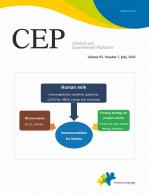Immunonutrition, an intervention or care practice that enhances innate immunity, particularly enteric immunity, or modifies risk factors that impair intestinal integrity or immunity, can prevent and improve disease outcomes in infants and children [1,2]. Park discussed the immunological function of several nutrients for infants, mainly focusing on human milk [1].
Human milk, a major source of immunonutrients in neonates and infants, provides bioactive components that stimulate postnatal immune maturation, facilitates immune tolerance, and develops the intestinal microbiome [3]. It contains dietary antigens, immunoglobulins, lactoferrin, lysozyme, glycoconjugates, oligosaccharides, and other cell types.
Human milk oligosaccharides (HMOs) were first described as ‘gynolactose’ in 1930 [4]. HMOs are classified into 3 categories: fucosylated (neutral), nonfucosylated (neutral), and sialylated (acidic), representing 35%–50%, 42%–55%, and 12%–14% of the total HMO content, respectively. The composition of HMOs varies among individuals and is determined genetically. Secretor (Se+ and Se-) and Lewis (Le+ and Le-) blood group systems are composed of four milk groups: (1) Se+Le+, which secrete all HMOs; (2) Se+Le-, which secrete 2'-fucosyllactose (2'FL), 3FL, lacto-N-fucopentaose (LNFP) -I, and LNFP-III; (3) Se-Le+, which secrete 3FL, LNFP-II, and LNFP-III; and (4) WeLe-, which secrete 3FL, LNFP-III, and LNFP-V [3]. The amount of HMOs also varied according to the course of lactation. Colostrum contains 20–25 g/L of HMOs, and the concentrations decline to 5–20 g/L, whereas bovine milk contains 0.05 g/L of oligosaccharides, the majority of which are sialylated [5].
Infants lack an enzyme system that can degrade HMOs, which reach the colon undigested and act as prebiotics and promote the growth of commensal bacteria. The beneficial effects of HMOs include inhibition of microorganism adhesion to the gut mucosa through interaction of the commensal microbiome, improvement of gut barrier function through indirect increase of short-chain fatty acid mediated by bifidobacterial species, and immunomodulation by the inhibition of toll-like receptors [1].
Randomized controlled trials of HMOs in humans were recently reported. A study randomized 87 healthy neonates to an intact-protein cow’s milk formula group, and 88 neonates to the same formula with 1.0 g/L 2'-FL and 0.5 g/L lacto-N-neotetraose (LNnT) for 6 months. Infants consuming HMO-supplemented formula showed softer stools, fewer nighttime wake-ups, and lower morbidity rates, including bronchitis, respiratory tract infections, and antipyretic and antibiotic use through 12 months [6]. In a subsequent study, they reported that the gut microbiota composition of fortified formula-fed infants with 2'FL and LNnT was closer to that of breastfed infants and significantly different from that of infants fed regular formula. The test group showed a higher abundance of Bifidobacterium and a lower abundance of Escherichia, similar to the breastfed group. Formula-fed infants with a higher abundance of Bifidobacterium at 3 months used significantly less antibiotics during the first year. A lower risk of infection with HMOs may be linked to intestinal microbiota composition [7]. The recent NEOLACTO study revealed no effects of bovine lactoferrin in preventing lateonset sepsis and promoting neurodevelopment in 414 infants with a birth weight of 500–2,000 g [8]. The secondary outcomes analyzed 153 very-low-birth-weight (VLBW) infants and their mother’s milk samples for >30 days. They measured HMOs using high-performance liquid chromatography. Overall, the secretory phenotype comprised 93% of the sample. The most abundant HMOs were 2'-FL and LNFP-I in secretors and lactoN-tetraose and LNFP-II in non-secretors. Mature milk had more diverse HMOs than colostrum. They found that fucosyldisialyllacto-N-hexose in colostrum might protect VLBW infants from late-onset sepsis [9].
Recent studies targeted infant formulas fortified with selected HMOs, mainly neutral HMOs. These formulas lack acidic HMOs, which may play a role in the inhibition of microorganism adhesion to the gut barrier. Moreover, they did not explain this mechanism. Further studies should investigate the roles of HMOs in the prevention of infectious diseases, including diarrhea and respiratory tract infections, and other diseases such as allergic diseases. Park emphasized the importance of breastfeeding during viral pandemics. In the near future, we may see the impact of breastfeeding in the era of the coronavirus disease 2019 pandemic.





 PDF Links
PDF Links PubReader
PubReader ePub Link
ePub Link PubMed
PubMed Download Citation
Download Citation


